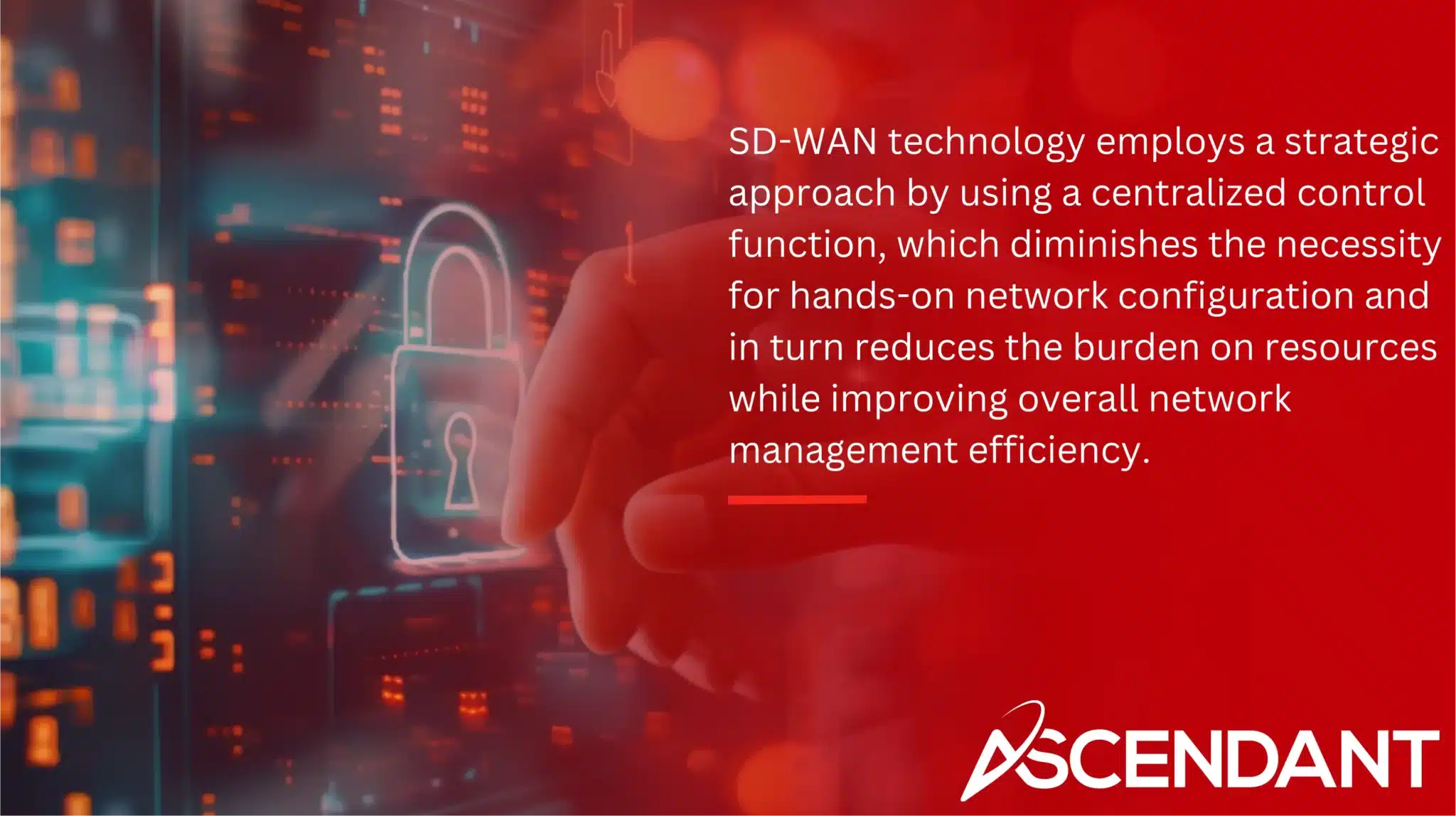SD-WAN, or Software-Defined Wide Area Network, modernizes network management. It enhances performance and reduces costs while offering more flexibility than traditional networks. This guide explores how SD-WAN works and its key benefits.
Key Takeaways
- SD-WAN enhances network performance and reliability by utilizing centralized control and application-aware policies, enabling efficient traffic routing across diverse connections.
- Adopting SD-WAN can significantly reduce operational costs, improve flexibility, and simplify network management, making it an effective solution for organizations of various sizes.
- Integrating SD-WAN with advanced security features and automation tools, including AI and machine learning, enhances both network security and performance, supporting modern IT infrastructure needs.
Understanding SD-WAN Technology
Software Defined Wide Area Networking, or SD-WAN, is a transformative technique for handling wide-area networks that moves away from the limitations of traditional WAN technologies. These legacy systems frequently face challenges in adapting to cloud services and scaling effectively. In contrast, SD-WAN leverages software-defined solutions to unify various network links easily and offers improved integration with cloud-based services. It bolsters branch office connections by increasing dependability and streamlines network management while boosting application performance and overall agility.
Adopting principles from Software-Defined Networking (SDN), SD-WAN operates on a software-defined framework which elevates both application functionality and end-user experience through an architectural separation between control commands and data routing processes. This division grants centralized oversight over the entire network infrastructure, making it easier to manage while fostering a nimble environment ready to adapt swiftly as demands change.
In direct comparison with its predecessor—the traditional WAN model that often relies on expensive carrier-specific solutions—SD-WAN champions independent connectivity across numerous Internet Service Providers (ISPs). This strategic shift not only diminishes expenditure, but concurrently amplifies network resilience along with enhancing connection quality by using optimally performing links available at any given time.
How SD-WAN Works

SD-WAN technology employs a strategic approach by using a centralized control function, which diminishes the necessity for hands-on network configuration and in turn reduces the burden on resources while improving overall network management efficiency. The essence of SD-WAN lies in its ability to steer application traffic intelligently across various transport methods through policy-driven decisions. This is achieved via SD-WAN appliances that form secure tunnels, managing data flows according to pre-established policies for safe and effective transmission.
By incorporating an overlay architecture with central governance, SD-WAN streamlines how services are delivered and managed at branch offices. It facilitates simpler device integration, template-based provisioning of application services, and streamlined security configurations. By considering current conditions along with set guidelines during routing processes, it ensures that applications receive appropriate bandwidth allocation and prioritization thereby upgrading network performance.
Compared to traditional WAN solutions, SD WANS possess superior capabilities for discerning the nature of application traffic — effectively converting requirements defined within individual app SLAs into actionable networking directives. Thanks to this awareness pertaining specifically to applications’ needs regarding routing strategies allows dynamic handling of such flow patterns. Thus securing accelerated delivery speeds as well as more proficient access pathways towards cloud environments when implementing SD WANS consideration must be given toward designing the underlying infrastructure factoring all variables from available bandwidth capacity onto anticipated behaviors emerging from different types of programs or systems used within any particular setup.
Application Awareness and Policy Control
SD-WAN technology excels in enhancing application performance by utilizing policies that are aware of individual application needs. This ensures traffic is managed according to the unique demands of each application, resulting in superior delivery and an optimized user experience. In modern varied networking landscapes where applications have disparate requirements, such granular optimization is essential.
To this, SD-WAN boosts both availability and responsiveness of applications through a policy framework that automatically assesses WAN performance on an ongoing basis. By constantly monitoring WAN conditions, it guarantees consistent application accessibility and reactivity—a vital component for preserving exceptional user experience levels.
Benefits of Adopting SD-WAN Solutions
The implementation of SD-WAN solutions brings forth several advantages that are particularly appealing for enterprises of varying sizes. One notable benefit is the increased cost-effectiveness. Especially for small and medium-sized businesses, switching to SD-WAN can lead to substantial savings by avoiding the hefty costs associated with traditional private circuits. With a possible return on investment reaching up to 243%, investing in SD-WAN proves to be a fiscally prudent choice. Enhancements from WAN optimization also contribute significantly to superior network performance.
Furthering this advantage, improved network performance stands out as another compelling perk of embracing SD-WAN technology. By prioritizing traffic routing for essential services and adhering strictly to service level agreements (SLAs), application quality of experience (QoEx) is greatly optimized through these networks. Intelligent bandwidth allocation across numerous connections via load balancing markedly bolsters overall network efficiency.
Finally, there’s an undeniable revolutionization within IT departments thanks largely due in part because they now enjoy streamlined management processes courtesy of these innovative systems offer – such ability manage things centrally coupled alongside features like “zero touch provisioning” which allows rapid deployment scales without needing manual intervention simplifies operations immensely providing more profound insights regarding apps devices & user behaviours leading simpler configurations easier handling tasks managing infrastructure.
Cost Efficiency
By allowing the utilization of multiple transportation modes such as broadband and cellular connections, SD-WAN enables organizations to cut down on operational costs. This adaptability helps businesses dodge expensive private circuit fees, thus establishing SD-WAN as an economical networking option.
Enhanced Network Performance
SD-WAN optimizes the use of bandwidth via load balancing, leveraging several connections to boost both availability and resilience. This proves particularly advantageous for entities that rely on vital applications requiring steady network performance and reduced periods of inactivity. Quality of Service (QoS) policies play a crucial role within SD-WAN frameworks by allocating higher priority and requisite bandwidth to essential applications, thereby elevating overall network efficacy.
Incorporating AI-driven analytics into SD-WAN significantly curtails network outages by fine-tuning performance levels and swiftly rectifying problems as they arise. The ability to monitor network performance in real-time allows for the detection of inefficiencies, facilitating prompt adjustments that help maintain optimal operational conditions for the network.
Simplified Network Management
Utilizing SD-WAN enhances the efficiency of network management, as it permits centralized oversight that eases scaling efforts and makes configurations and operations more straightforward. The implementation of zero-touch provisioning within this technology framework expedites the deployment process for new locations and services by eliminating manual processes, leading to a substantial decrease in time and effort associated with growing the network.
SD-WAN boosts IT flexibility through improved distribution of resources across various settings. With AIOps integrated into SD-WAN operations, routine tasks are subject to automation, which assists not only in identifying anomalies but also in refining maintenance protocols. This level of automation results in lower costs related to continuous network administration while simultaneously providing deeper insights regarding the health and performance metrics of the network infrastructure.
Secure SD-WAN: Enhancing Network Security
Adopting SD-WAN offers a significant advantage in bolstering network security. By incorporating security functionalities within the process of managing networks, SD-WAN streamlines setup and guarantees uniform protection throughout the entire network infrastructure. Such consolidation enables enterprises to defend against external dangers like DDoS incursions and malicious software, while simultaneously preserving secure inter-site communication through encryption.
With its capability for programmatically controlling networks, SD-WAN notably enhances an organization’s defense mechanisms. When it comes to networking across various branch offices, SD-WAN equips these extensions with inherent safety features that safeguard access to enterprise systems securely. Consequently, this makes SD WAN a superior option for organizations with geographically dispersed operations seeking reliable and protected connectivity.
Zero Trust Network Access
SD-WAN leverages end-to-end encryption and zero trust network access, a vital aspect of contemporary network security, to guarantee that only authenticated and authorized individuals have the capability to interact with confidential applications. This ensures the protection of company assets by securing connections for remote workers against unauthorized entry.
Integrated Security Services
Secure SD-WAN solutions are distinguished by their integration of security services, which encompasses complete encryption from start to finish, extensive threat identification capabilities, and sophisticated features provided by next-generation firewalls (NGFW). By merging the functionalities of SD-WAN with NGFWs, advanced routing systems, and Zero Trust Network Access (ZTNA) application gateways, secure SD-WAN enhances an organization’s defense mechanisms.
Taking Fortinet Secure SD-WAN as an example, it offers security packages powered by artificial intelligence that boost the effectiveness of protection measures. Through this synthesis of technologies, organizations can bolster both their security and performance metrics. This ensures a robust shield for data integrity and application safety within a company’s network infrastructure.
Comparing SD-WAN with Traditional WAN Architectures
When weighing up SD-WAN against traditional WAN setups, it’s clear that SD-WAN holds numerous benefits. While conventional WAN solutions such as MPLS may be expensive and rigid, which can stifle growth and adaptability, an SD-WAN approach offers a more affordable option that scales easily while ensuring secure connections through the use of various Internet Service Providers (ISPs).
By allowing for real-time routing of WAN traffic across the most optimal paths available, SD-WAN enhances both agility and performance. This proves especially advantageous for businesses with fluctuating networking needs or those heavily reliant on cloud-based services due to its ability to alleviate network congestion and heighten operational effectiveness.
SD-WAN vs. MPLS Networks
Utilizing SD-WAN can lead to reduced operational expenses in contrast to MPLS, offering a cost-effective alternative. The system elevates adaptability for enterprises by providing the option to augment or supplant MPLS connections using broadband internet, which contributes to quicker implementation and greater flexibility.
Performance-wise, SD-WAN is capable of delivering a level of service comparable to that of MPLS due to its ability to direct application traffic through the most optimal pathway instantaneously. This capability enhances overall performance while mitigating bottlenecks.
SD-WAN vs. VPN
SD-WAN surpasses traditional VPNs when it comes to affordability, efficiency, and dependability. Unlike VPNs that rely on a single link, SD-WAN leverages various transport channels to route data traffic, which enhances overall performance while minimizing interruptions.
Incorporating service-level agreements (SLAs) tailored for high-performance metrics, SD-WAN delivers enhanced features such as Quality of Service (QoS) and application-specific routing. These capabilities render it exceptionally suitable for extensive workforces operating remotely with an sd-wan setup.
The Role of SD-WAN in Modern IT Infrastructure
SD-WAN is a pivotal component in contemporary IT frameworks, providing superior compatibility with cloud services over conventional WAN solutions. With the growing shift towards cloud adoption by enterprises, there’s an anticipated increase in the implementation of SD-WAN systems that are based on the cloud. By syncing application modernization efforts with network functionality, SD-WAN proves to be integral for a coherent transition into multi-cloud setups.

Incorporating SD-WAN within organizational IT strategies enables streamlined assimilation of cloud technologies while fostering digital advancement. It stands as a crucial support mechanism for current-day IT infrastructures through its ability to boost connectivity to the cloud and ease expansion with additional cloud-based resources without introducing undue complexity.
Cloud-Based SD-WAN Deployments
SD-WAN enhances the performance and reliability of internet-based traffic, thereby improving connectivity to cloud services. It does so by providing dynamic routing directly to these services, circumventing the requirement for data rerouting via central data centers, which boosts efficiency in cloud-dependent processes.
By enabling branch offices to establish direct connections with cloud services, SD-WAN considerably improves the user experience. This is achieved by offering optimized access to cloud applications and removing conventional congestion points.
Supporting Hybrid WAN Architectures
By integrating different WAN technologies, SD-WAN allows companies to utilize both private and public networks in a cohesive manner. The hybrid approach of combining MPLS with SD-WAN offers dependable connectivity and provides the added benefit of flexible traffic routing.
The fusion of these elements results in the efficient utilization of network infrastructure resources, which improves not only performance but also the reliability of network operations.
Future Trends in SD-WAN Technology
SD-WAN technology stands on the brink of substantial progress, with AI and machine learning playing key roles in its evolution. These enhancements will lead to improved network performance and heightened security measures by facilitating smarter traffic control and prescient analytic capabilities. Amidst escalating security issues, SD-WAN solutions are set to integrate enhanced firewall technologies and VPNs for comprehensive network traffic protection.
Simultaneously, there’s a surge towards zero-touch provisioning that promises automated setup processes for SD-WAN installations, drastically reducing the need for hands-on configuration. As 5G networks emerge more prominently into the technological landscape, they’re expected to significantly influence SD-WAN solutions by offering accelerated data speeds along with superior consistency in connectivity.
SD-WAN and Secure Access Service Edge (SASE)
Incorporating Secure Access Service Edge (SASE) marks a significant advancement in the SD-WAN landscape. By merging sophisticated security services into SD-WAN, SASE facilitates secure and streamlined access to cloud-based resources. It establishes zero-trust network access managed from a central point, guaranteeing that only authenticated identities can gain entry.
When combined with SD-WAN, SASE enhances multiple layers of defense including web gateways, isolates browsers remotely for added protection, manages encryption and decryption processes efficiently, and incorporates Firewall as a Service. This all-encompassing strategy allows enterprises to uphold stringent security measures while reaping the agility and improved performance associated with SD-WAN.
AI and Machine Learning in SD-WAN
The incorporation of AI and machine learning into SD-WAN enhances its proficiency by providing smarter traffic management and augmented visibility into how applications perform. These advanced technologies have the ability to recognize irregularities in network traffic flows, which allows for the preemptive detection of issues that could otherwise hinder application performance.
By leveraging AI-fueled automation, SD-WAN can dynamically fine-tune network pathways and allocate resources as needed according to live conditions and observed patterns of use. This anticipatory strategy guarantees optimal network function, delivering an uninterrupted and dependable experience for users.
Real-World SD-WAN Use Cases
Various sectors, including healthcare, banking, retail, and transportation, are embracing SD-WAN technology for its distinctive ability to boost network performance and efficiency while fortifying security. An example of this adoption is seen in how CaixaBank has scaled up and improved services by integrating Fortinet Secure SD-WAN.
The bespoke nature of SD-WAN solutions allows them to cater precisely to the requirements of each industry sector, offering consistent connectivity along with enhanced performance metrics. The versatility and customizability provided by SD WAN make it a perfect choice for an array of networking contexts that demand reliable and secure connections.
Branch Office Connectivity
SD-WAN technology offers a solution to the limitations experienced by branch offices with conventional MPLS connections, such as the requirement for traffic to be routed via the corporate network. This process can detrimentally affect both network performance and latency, thereby hampering remote employees’ ability to access company resources swiftly. SD-WAN improves service provision at branch locations by directly sourcing networking, security, and voice services from the cloud, this results in quicker resource accessibility.
For organizations that operate multiple branches, SD-WAN provides quick deployment of connectivity options at these office sites while simplifying network management across various locations. The use of SD-WAN ensures uniformity in terms of network performance and security throughout all branches within an organization’s portfolio.
Supporting Remote Workforces
SD-WAN ensures secure and reliable connectivity for telecommuters, enhancing teamwork and interaction among colleagues. It enhances application performance for those working remotely, guaranteeing uniform user experiences irrespective of their geographical position. This feature is essential in allowing organizations to preserve efficiency and productivity within a remote work setting.
How to Deploy SD-WAN Effectively
Implementing SD-WAN efficiently necessitates meticulous strategy and implementation. Automated deployment and configuration facilitated by zero-touch provisioning enable a smooth introduction of SD-WAN solutions. Centralized management provides the capacity for immediate alterations to security protocols while also easing routing adjustments in accordance with application policies, which promotes effective network administration.
The automation associated with SD-WAN expedites the processes involved in deployment and setup, thus reducing complications inherent in managing networks. This method endorses the programmatic oversight of devices and networking infrastructures, significantly decreasing the need for manual handling and boosting overall operational effectiveness.
Preparing for SD-WAN Implementation
Getting ready for SD-WAN deployment entails outlining the network structure, gauging required bandwidth levels, and grasping the behavior of application traffic. The intelligence within SD-WAN architecture has been amplified thanks to the software-defined approach, guaranteeing that the WAN architecture can adjust to changing needs while maintaining peak efficiency.
Managing SD-WAN Deployments
The process of managing SD-WAN deployments necessitates conducting tests in scenarios that mimic actual usage to ascertain the network’s performance and dependability before it is widely implemented. With its enhanced velocity, ability to scale, and adaptability, a cloud-delivered SD-WAN stands out as an optimal solution for contemporary network structures. The adoption of centralized management streamlines activities related to setting up and sustaining branch offices while preserving uniformity in both network performance and security throughout various locations.
By employing secure SD-WAN solutions, businesses can gain operational efficiencies by automating the architecture design, deployment processes, and daily operations alongside having central oversight with comprehensive reporting capabilities. Support offerings like FortiCare augment these services by providing reviews on operational procedures along with rapid replacement services for any faulty equipment which contributes to keeping downtime at bay while maintaining peak network efficiency.
Summary
SD-WAN technology stands out as a potent tool in the realm of contemporary network management, delivering key advantages over traditional WAN setups. It notably improves network performance, lowers expenditure, and streamlines the managerial process, benefits that resonate with enterprises large and small. SD-WAN also incorporates advanced security features while adeptly accommodating cloud-based and hybrid environments, affirming its importance in today’s IT landscapes.
As digital transformation becomes increasingly integral to organizational strategy, SD-WAN is poised to become essential for ensuring consistent and effective network functionality. By integrating SD-WAN into their operations, companies can gain enhanced connectivity options along with heightened security measures while fostering an environment marked by significant operational nimbleness—critical attributes for thriving within the digitally-oriented business world.
 Frequently Asked Questions
Frequently Asked Questions
What is SD-WAN?
SD-WAN, or Software-Defined Wide Area Networking, is a technology that enhances the management and operation of a Wide Area Network by separating the networking hardware from its control mechanisms, thereby increasing efficiency and flexibility.
How does SD-WAN improve network performance?
SD-WAN enhances network performance through centralized policy-driven traffic steering and dynamic routing, which optimize bandwidth usage and ensure high availability.
This results in improved application performance and reliability.
What are the cost benefits of adopting SD-WAN?
Implementing SD-WAN can lead to considerable cost savings for organizations by leveraging a variety of transport options, thereby circumventing the expenses associated with private circuits. This could result in a return on investment as high as 243%.
The shift towards SD-WAN technology may facilitate significant reductions in operational expenditures over time for companies.
How does SD-WAN enhance network security?
SD-WAN enhances network security by integrating advanced features such as end-to-end encryption, threat detection, and next-generation firewall capabilities directly into the network management process.
This integration helps protect data and maintain secure connectivity across the network.
What is the difference between SD-WAN and traditional WAN architectures?
The difference between SD-WAN and traditional WAN architectures lies in SD-WAN’s flexibility, cost-effectiveness, and superior performance, as opposed to the often expensive and rigid nature of traditional WAN solutions like MPLS.
Thus, SD-WAN is the more modern and efficient choice for network management.

